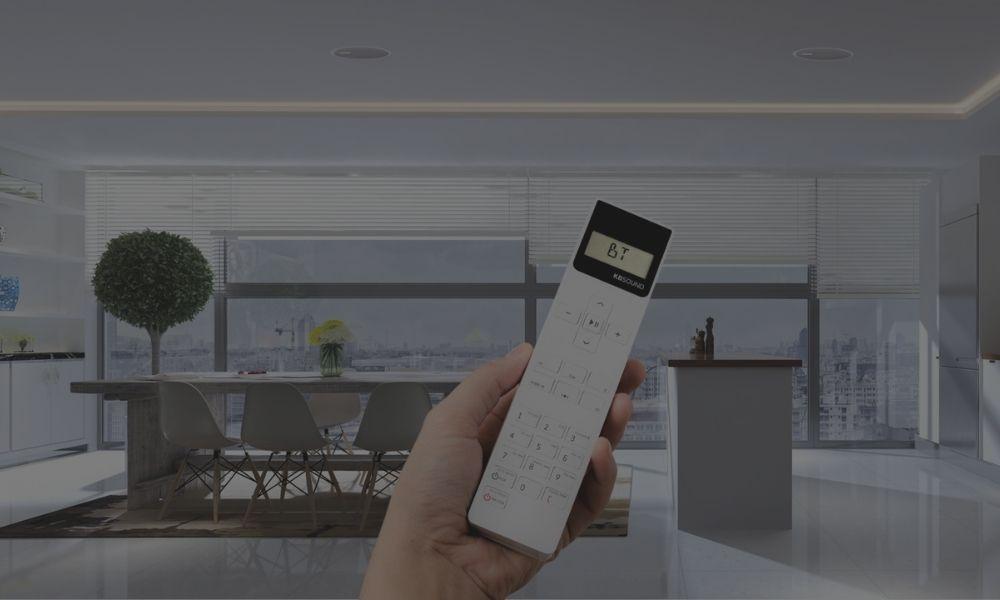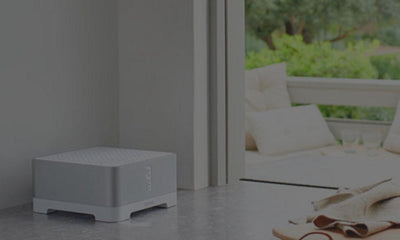We've been helping customers buy and install kitchen radio systems for a good few years now, we've come across various different kitchen sizes, shapes, types, requirements. Many home owners don't realise how simple and cost effective it can be to have an installed kitchen radio in your home.
Having an installed radio system in your kitchen will get a lot of use for many years from all of the family, it's great for entertaining with friends, to listen to the news whilst eating breakfast and for listening to your favourite songs at dinner time.
All with no wires or batteries to charge!
Once you see the benefits of an installed kitchen radio system you'll never want to be without one.
Why You Should Install Speakers In Your Kitchen
Let's start with the why? Everyone loves music of some kind whether it's classical, rock, RnB or Rap! An installed kitchen radio system in your home will allow you to listen to your favourite tunes or radio station at the touch of a button, all with high quality room filling sound.
Key Benefits:
- Listen to your favourite music with room filling sound.
- Catch the news at breakfast.
- Set the scene with romantic music at dinner.
- Impress your friends at dinner parties.
- Turn it up for a house party.
- Learn to cook with YouTube cooking programs and hear the sound through the ceiling speakers.
- Connect your kitchen TV and improve the sound quality.
There are quite a few choices with adding music to your kitchen and it can seem a bit confusing, that's why we've written this guide and we've also categorised our website to suit the various types of kitchen radio system to make it easy to understand and choose.
My kitchen radio gets a lot of use, it's the first thing to turn on when I arrive home from work, we listen to the radio at dinner and stream our favourite songs when entertaining friends. My two year old loves dancing around the kitchen and this alone made the system worthwhile. We've put our personal experience into creating this guide and website and if it helps just one person choose a radio system we'll be happy!
The first thing you need to decide when selecting a kitchen radio is which type of kitchen radio is right for you. Kitchen radios fall into four main categories.
There Are 4 Main Types Of Kitchen Radio System
-
In Ceiling Radio System - Ceiling speakers mounted in your room with an amplifier that either sits above the ceiling or is built into the ceiling speaker itself, they are usually controlled from a remote control or smart phone/tablet app. The latest speakers tend to feature bluetooth with some speakers simply needing to pair your phone and play music without the need for special apps. These systems can often be easily installed into most kitchen ceilings, even completed kitchens as they do not require any wiring to wall keypads or separate amplifier units.
-
In Wall Radio System - These systems still use ceiling speakers in your room, but they also feature a physical in wall keypad which allows you to turn your radio system on/off, volume etc. These systems may also include a remote control and are ideal for people who want to turn the radio on with a button press, not using a mobile phone or tablet.
-
Retrofit Radio System - Retrofit kitchen radios are typically installed on top of kitchen cupboard units and connected to the local power, they feature free standing bookshelf speakers or satellite speakers. These systems are ideal for rented properties or finished kitchens where you are unable to get cables into the ceilings or walls.
- Free Standing Radio System - These systems are typically traditional hi-fi style units that will sit on your kitchen worktop and plug into a local socket. Systems such as the Sonos Play would be deemed as a freestanding kitchen radio.
Different Types Of Speakers For Your Kitchen
When selecting your kitchen radio it is good to understand the different types of speakers, how they differ and where you would use each type.
Then you can decide which is the right solution for your home.
1. In Ceiling Speakers
These are the most common speakers sold with our systems and bought by our customers. They are discreet and fit flush in the ceiling, there are no visible cables and they often blend in nicely with the ceiling. Ceiling speakers also provide a good quality sound in kitchens and can offer better sound coverage than bookshelf speakers, especially in larger kitchens.
Ceiling speakers come in various sizes, the most common are 2.5", 5", 6.5", 7" and 8". The size relates to the driver, the actual speaker part that produces the sound, not the overall dimensions so bear in mind that a 6.5" ceiling speaker is actually about 9" wide.
Is bigger always better? Not necessarily, the bigger the cone the more bass the speaker can produce, however bear in mind that the speaker is only as good as what you connect it to, a lot of our systems are around 18w per channel, this will provide loud, room filling sound, but you won't see the benefits of a high definition 8" speaker from this amplifier. We recommend for kitchens that you go for at least a 5" two way ceiling speaker with 6.5" speakers being our best sellers.
2. In Wall Speakers
There are some situations where you're unable to install a ceiling speaker, maybe you have a vaulted ceiling, a large roof light or maybe there are already too many items on the ceiling (lights, extractor fans, etc) leaving no room for ceiling speakers.
In these situations you could look to in wall speakers. They look very similar to ceiling speaker and work in the same way, however they are usually rectangular in shape rather than round.
Much like ceiling speakers, in wall speakers also come in different sizes ranging from 4" up to 8" and the same thing goes with amplifier power for most kitchen radio systems meaning that bigger isn't always better. The most common size is 6.5". Sound coverage can be reduced when using in wall speakers so for larger rooms consider using two pairs of in wall speakers to cover the room adequately.
3. Bookshelf Speakers
When someone says "speaker" the majority of people will think of a free standing self contained "box" speaker traditionally used with HiFi systems. This is what we refer to as a bookshelf speaker.
There are many options with bookshelf speakers, we've got some of the most commonly used bookshelf speakers for kitchen radio systems.
Generally you won't want a large speaker taking up space on your counter, so look for a smaller "satellite" style speaker that can be mounted discreetly on top of the kitchen units.
One of the major benefits of using a bookshelf speaker is that you don't need to make holes in your walls or ceilings, this means you can usually retro fit a kitchen radio system into a fully finished kitchen by placing bookshelf speakers on top of kitchen units and installing a wireless bluetooth amplifier in a kitchen cupboard. This means if you have a finished kitchen you can still achieve a high quality kitchen radio system without causing any damage requiring re-decoration!
Kitchen Radio Features

Once you've decided whether you're having an in wall or in ceiling system, and you've also chosen your speaker types you need to think about how you want to use your system.
Where is your favourite music?
Kitchen radios come with various features, some systems have them all, some don't... here's a breakdown of the different features and what they offer:
FM Radio - Hopefully everyone is familiar with FM radios! This is the most common feature and allows you to listen to FM radio channels, favourite stations can be set and recalled from the memory for quick access to your top stations.
DAB Radio - DAB is a higher quality version of FM radio. With a good aerial connection you'll receive a much higher quality sound from your favourite radio stations.
Bluetooth - This is fast becoming the most popular and most requested feature of all speakers, portable and installed. Bluetooth is a way of connecting your smartphone, tablet or PC to the amplifier and allows you to stream content from your device in high quality. Bluetooth is quick, easy and very reliable. It doesn't require any special apps, any audio content from your phone, from any app, can be streamed to the music system. It's also not dependent on manufacturer, so any Bluetooth device be it Apple, Samsung, HTC, iPod, you name it.. if it has Bluetooth it will work. Bluetooth's only limitation is the range, typically about 10m if you stray further than this you may lose your connection which will stop the music playing. For the majority of kitchen installations this is not a problem.
Auxiliary Input - These are for physical wired connections to devices such as televisions, iPod's and CD players. If you prefer to physically plug in your device then look for a system with an auxiliary input on the front panel. Some systems have an auxiliary input on the rear of the amplifier, this is great for connecting televisions, CD players and other wired devices without any visible cables. We often have customers connecting a WiFi streaming box to their kitchen radio systems to give them access to internet radio and other services.
Wi-Fi Streaming - Since the introduction of Sonos Wi-Fi streaming has become hugely popular. Wi-Fi streaming requires a streaming box such as Sonos, Musaic, Denon (and many more) which allows you to choose internet radio stations and music streaming services from their bespoke app. Wi Fi streaming is not affected by range as the music is played from the streaming box, not the smartphone/tablet. Having a Wi-Fi streaming box also gives some other advantages such as alarm clock functionality and often you can turn the system on, adjust volume etc. from the smart phone app without having to set any inputs on an amplifier.
Airplay & Chromecast - Whilst these formats may limit you to a certain type of device (iOS or android) they are very good low cost streaming alternatives. With Airplay you can simply connect your iOS device to any Airplay receiver and stream any content from your device. Chromecast works in much the same way on android and via app on iOS. You can even create multi room zone linking with Chromecast.
Other Things To Think About
We recommend you install an external or loft mounted aerial.
All of our kitchen radio systems include a short aerial and this may be good enough for most circumstances, but for optimal performance we recommend that a roof or loft mounted aerial is installed and connected to your new kitchen radio system.
This guarantees that you'll be able to listen to your favourite radio stations in great quality.
Where to site the in wall keypad?
This depends greatly on the kitchen layout, the radio wall panels we sell fit on a 1 gang or 2 gang electrical box and we recommend to either install it next to the light switch when you enter the room, or behind the kitchen worktop adjacent to sockets etc. As long as the panel is not cited next to the sink you can place it wherever you feel best. Try to keep it accessible for the whole family to enjoy and in a place that isn't awkward to get to, you want your radio system to complement your lifestyle. We've even seen the panels flush mounted into kitchen cabinet doors and panels!
You might need professional installation.
Most of our kitchen radio systems do require some form of installation, however they are quite easy to install and most of our bundles come with everything you need including speaker cable. We have carefully chosen products that can be installed by most competent DIY'ers, but if you're not confident at DIY then we would recommend that you engage a friendly electrician to install your system.
All of our systems come with instruction manuals, which are also freely available on our website. We are also happy to discuss the installation with you or your electrician further.
Some of our products required direct connection to 230v electricity supply, in this instance we always recommend that a competent electrician is employed to make the connections.





